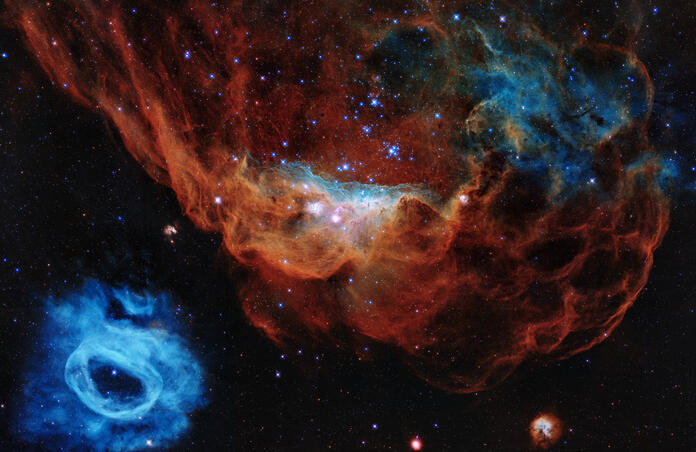Hubble Celebrates 30th Anniversary with a Brilliant Image of the ‘Cosmic Reef’

On April 24th, 2020, NASA and ESA celebrated the Hubble Telescopes 30th anniversary by capturing a stunning visible-light image of the ‘Cosmic Reef.’ The image showcases two colorful and Illustrious nebulae, NGC 2014 and NGC 2020. Though they appear to be independent, the two nebulae both reside in the same star-forming region, known as the Large Magellanic Cloud. The area is over 163,000 light-years from Earth and is called the 'Cosmic Reef' because it bears a striking resemblance to a colorful ocean reef.
The Cosmic Reef: NGC 2014 and NGC 2020
Aside from being beautiful to look at, observing NGC 2014 and NGC 2020 provides valuable insight into star formation and evolution. The stars residing in these nebulae are much brighter and more massive than our Sun but live relatively short lives—most only live a couple of million years, compared to our Sun's 10-billion-year lifespan.
A short video visualization of the structure of the Cosmic Reef. It was developed using pictures captured by the Hubble Space Telescope. Credit: NASA, ESA, STScI (Full List)
NGC 2014, the much larger nebula (the upper red one), contains a bright center cluster of stars undergoing violent formation. The force of the formations has blown out gas and dust in every direction, and intense ultraviolet radiation emanating from the group helps light-up the entire nebula. According to ESA’s press release for the image, the stars also emanate powerful winds that erode the gas around specific locations in the nebula, forming bubbly-looking areas. "The gas in these areas is less dense, making it easier for the stellar winds to blast through them, creating bubble-like structures reminiscent of coral."
The lower blue nebula, NGC 2020, formed much the same way that NGC 2014 did, only it’s the work of one massive star. The star, which is nearly 200,000 times brighter than the Sun, belongs to a rare class of stars, known as Wolf-Rayet stars. Wolf-Rayet stars are incredibly hot, burn through their hydrogen quickly, and produce strong stellar winds. The nebula glows in a lovely blue color because of the intense heat of the oxygen gas, at around 11,000 degrees Celsius (19,832 degrees Fahrenheit).
Conclusion
Since its launch in 1990, the Hubble Space Telescope has provided a mountain of beautiful images and valuable data. To date, it has performed over 1.4 million observations and provided data for over 17,000 scientific studies. Though it's going to be replaced by the James Webb Telescope next year, this visible-light image of the 'Cosmic Reef' is a fitting tribute to its exceptional work over the years.